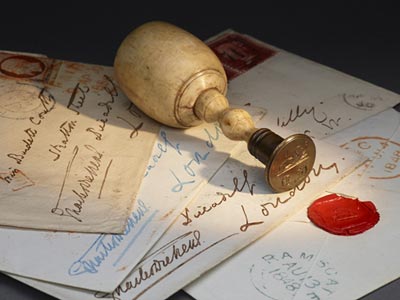 This blog features letters from Charles Dickens drawn from the Morgan's collection, which includes over 1,500 of his letters. The Morgan has the largest collection of Dickens's letters in the United States, surpassed in number only by the Dickens House Museum, and the Victoria and Albert Museum, in London. Posts will include images of Dickens letters with a complete transcription, and a brief commentary on content and context. A Letter from Charles Dickens will allow readers of the blog to discover for the first time—or renew their acquaintance with—Dickens's notable letters.
This blog features letters from Charles Dickens drawn from the Morgan's collection, which includes over 1,500 of his letters. The Morgan has the largest collection of Dickens's letters in the United States, surpassed in number only by the Dickens House Museum, and the Victoria and Albert Museum, in London. Posts will include images of Dickens letters with a complete transcription, and a brief commentary on content and context. A Letter from Charles Dickens will allow readers of the blog to discover for the first time—or renew their acquaintance with—Dickens's notable letters.
Needless to say, I needed to be extremely selective when deciding which of the Morgan's letters to include in the exhibition Charles Dickens at 200. The twenty letters that will be on display from September 23, 2011, until February 12, 2012, represent less than a third of the exhibition checklist, and a tiny percentage of the Morgan's collection. This was to allow the inclusion of a representative selection of important literary manuscripts, printed editions, photographs, original illustrations, caricatures, playbills, and realia (some everyday objects owned and used by Dickens).
This blog aims to redress the exclusion of some remarkable letters that, for various reasons, did not fit into the exhibition's seven sections, which includes topics as diverse as philanthropy and mesmerism. Posts will include images of a Dickens letter with a complete transcription, and a brief commentary on its content and context. Although almost all of Dickens's letters have been published in the magnificent twelve-volume Pilgrim Edition (1965–2002), many readers and admirers of Dickens's fiction may not be familiar with his correspondence. As the scholar John Butt pointed out half a century ago, Dickens's letters “make good reading in themselves,” and “throw light on the conditions in which a great novelist wrote his books.”
In his invariably idiosyncratic, exuberant, vivid, and amusing letters, Dickens “expressed both his mood and his mind on a great variety of topics with ease and freedom.” (John Butt, The Yale University Library Gazette, April 1962). His letters have been absolutely indispensable as source material for Dickens's numerous biographers, and are widely recognized as a significant body of work in themselves, part of the Dickens canon.
Dickens would be furious, of course. He reviled the idea of his letters being published and, to protect the privacy of those who wrote to him—and safeguard his own privacy—burned a huge amount of his incoming correspondence. Henry Dickens, one of Dickens's seven sons, recalled roasting onions in the ashes of the bonfire that consumed twenty years' worth of his father's correspondence in September 1860. As Claire Tomalin points out in her excellent new biography, “if he [Charles Dickens] had had his way, no one would have seen any of his letters.”
Dickens was not the only destroyer of letters: surprisingly, his closest friend, John Forster, whom Dickens nominated to write his biography, is believed to have burned all but fifty-five of the more than 1,000 letters quoted in the three-volume biography. As Tom Stoppard wrote in his play The Invention of Love, “posterity has a brisk way with manuscripts: scholarship is a small redress against the vast unreason of what is taken from us.” Fortunately, many of the recipients of Dickens's letters treasured and preserved them, and an astonishingly high number survive – approximately 15,000 are included in the Pilgrim Edition, which is reckoned to be a high proportion of the correspondence Dickens wrote.
